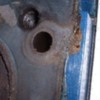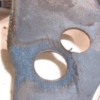Jack,
I shouldn't have spoken so soon about leakers....just fired my new engine up in the Goose a few minutes ago and found a couple of leaks!!!

One was easy but puzzling! Edelbrock water pump was blowing steam out a bolt hole...that wasn't leaking on the last engine!!! Nothing bolts to it in the Goose....nor did it before!?!!! Stuck a bolt with Form-a-gasket on it and it sealed up fine, water temp now settled down and happy!
Second leak....ugh....all over the floor, at the rear of the block....good news is that it wasn't coolant..... took some pic's for my "ooops I'm doing it again" post in the Goose section, tossed some kitty litter on the mess, and cleaned up.....shut off the lights!
Will see what's going on tomorrow or Thurs. Used a silicon one piece pan seal....and the block has the one piece oil seal (92 roller motor) so either I did some sort of boner thing like put the seal in backwards ( I really do not think so....) Now I am doubting myself....did I even install the rear seal???? That wouldn't be the first time I did a boner thing.......doh! Or the pan seal bunched up..... If I look in the gasket set and find a big round seal....well then...pretty danged obvious!!!! Stupid cars....stupid mechanics.....silly me!
Ciao!
Steve




